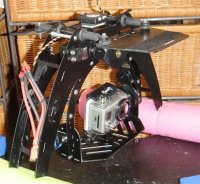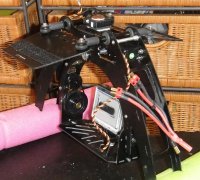GGoodrum
Member
There's a couple things I like about the mkTR Pro mount, from PhotoShip One. The first is that overall, it is very light. The second is that it has a very effective vibration isolation scheme, which uses two frame-mounted platforms, that also serve as battery trays, that have these very squishy rubber doughnuts, which act as "cushions" for two carbon fiber tubes that go through rubber grommets in the landing gear/mount. I think this setup provides close to the same amount of vibration isolation as does the patented system on my CineStar 6.
There are a couple of problems, however, with using this mount for video, in a "stock" configuration. First of all, the tilt axis uses a direct-drive setup so the movements tend not to be very smooth. My first attempt to improve the smoothness was to replace the standard Hitec digital servo with a high speed Align DS610 servo, which uses a 12-bit A/D converter in the electronics. This did, in fact, improve the smoothness, but still not enough. There's still a very slight, but detectable "stair-stepness" in the video.Clearly, some reduction is needed in order to smooth out the movements. PS1 does offer a od to the tilt axis that implements a geared 2:1 reduction, but this really needs to include a hires, 12-bit servo to have adequate performance. Also, gears can add play, or backlash into the mix. The version I had, which granted, was one of the original prototypes, had a bit of play and there's no way to adjust it out. What I did instead was to first use a 12-bit, very fast HS-7966HB digital and then converted the tilt axis to a belt drive. I chose 2:1 as the ratio, figuring that this will be a good tradeoff of speed vs smooth movements. I can tell you, it works quite well, and is buttery smooth now. :02.47-tranquillity:
The roll axis normally uses a single "mini"-sized servo, with a mechanical reduction of around 2:1, using a special servo horn and a special link that attaches to the arch. Again, in its stock configuration, this is not all that smooth, even with the reduction. Part of the problem is that there is a bit of backlash/play in the linkage. PS1 does offer a "fix" for this backlash problem, and that is to use two servos, with two sets of linkages that have slightly different lengths set into the servo horns. The idea here is that the servos fight each other slightly, which removes the backlash/play, but I was not very happy with the smoothness of this operation. My first attempt at improving this was to use two Savox SH-1357 digital minis, in place of the Hitec minis. This took a bit of shoehorning, to get them to fit, because they are slightly larger than the Hitecs, and they have a different output spline. In any case, this still didn't have enough smoothness. Part of the reason is that the Savox minis are 10-bit, not a full 12-bit. More than that, though, I couldn't get the servo horns adjusted just right, to not cause a little jitter. My latest change was to also convert the roll axis to a belt drive, and use the same ultra-fast, 12-bit Hitec HS-7966HB digital. This is a ton smoother, now just as "buttery" as the tilt axis.
Finally, what I came up with, mainly as a workaround for my issues with the wandering/drifting WK-M gimbal outputs, was the idea to use an XA FC and AHRS setup, in addition to the WK-M, but only to drive the gimbal servos. This works quite well, actually. Using the v1.31 firmware, it allows you to change the servo update rate. For some reason, they made this a fixed setting of 10ms/100Hz on the v1.33/v1.34 update, but v1.31 lets you change this, all the way down to 2ms/500Hz. There is a very noticeable difference between the two, for sure, especially for small movements. Actually, I'm guessing that the WK-M's output update rate is probably close to 10ms/100Hz as well, because it seems the same as the XA with v1.33/v1.34.
One other change I'm trying out is to move the XA's AHRS to the top of the mount, instead of being part of the platform. The idea here is that with the AHRS on the non-isolated side, it will be generating "corrections" to the gimbal servos, due to vibrations. With the gimbal on the other side of the isolation, these corrections will end up affecting the video, to some degree. By having the AHRS on the same side, it should theoretically work better. We'll see.
Anyway, this is now mounted back on my X8. It is too late today, but I will try and get some test flights in tomorrow.
-- Gary
There are a couple of problems, however, with using this mount for video, in a "stock" configuration. First of all, the tilt axis uses a direct-drive setup so the movements tend not to be very smooth. My first attempt to improve the smoothness was to replace the standard Hitec digital servo with a high speed Align DS610 servo, which uses a 12-bit A/D converter in the electronics. This did, in fact, improve the smoothness, but still not enough. There's still a very slight, but detectable "stair-stepness" in the video.Clearly, some reduction is needed in order to smooth out the movements. PS1 does offer a od to the tilt axis that implements a geared 2:1 reduction, but this really needs to include a hires, 12-bit servo to have adequate performance. Also, gears can add play, or backlash into the mix. The version I had, which granted, was one of the original prototypes, had a bit of play and there's no way to adjust it out. What I did instead was to first use a 12-bit, very fast HS-7966HB digital and then converted the tilt axis to a belt drive. I chose 2:1 as the ratio, figuring that this will be a good tradeoff of speed vs smooth movements. I can tell you, it works quite well, and is buttery smooth now. :02.47-tranquillity:
The roll axis normally uses a single "mini"-sized servo, with a mechanical reduction of around 2:1, using a special servo horn and a special link that attaches to the arch. Again, in its stock configuration, this is not all that smooth, even with the reduction. Part of the problem is that there is a bit of backlash/play in the linkage. PS1 does offer a "fix" for this backlash problem, and that is to use two servos, with two sets of linkages that have slightly different lengths set into the servo horns. The idea here is that the servos fight each other slightly, which removes the backlash/play, but I was not very happy with the smoothness of this operation. My first attempt at improving this was to use two Savox SH-1357 digital minis, in place of the Hitec minis. This took a bit of shoehorning, to get them to fit, because they are slightly larger than the Hitecs, and they have a different output spline. In any case, this still didn't have enough smoothness. Part of the reason is that the Savox minis are 10-bit, not a full 12-bit. More than that, though, I couldn't get the servo horns adjusted just right, to not cause a little jitter. My latest change was to also convert the roll axis to a belt drive, and use the same ultra-fast, 12-bit Hitec HS-7966HB digital. This is a ton smoother, now just as "buttery" as the tilt axis.
Finally, what I came up with, mainly as a workaround for my issues with the wandering/drifting WK-M gimbal outputs, was the idea to use an XA FC and AHRS setup, in addition to the WK-M, but only to drive the gimbal servos. This works quite well, actually. Using the v1.31 firmware, it allows you to change the servo update rate. For some reason, they made this a fixed setting of 10ms/100Hz on the v1.33/v1.34 update, but v1.31 lets you change this, all the way down to 2ms/500Hz. There is a very noticeable difference between the two, for sure, especially for small movements. Actually, I'm guessing that the WK-M's output update rate is probably close to 10ms/100Hz as well, because it seems the same as the XA with v1.33/v1.34.
One other change I'm trying out is to move the XA's AHRS to the top of the mount, instead of being part of the platform. The idea here is that with the AHRS on the non-isolated side, it will be generating "corrections" to the gimbal servos, due to vibrations. With the gimbal on the other side of the isolation, these corrections will end up affecting the video, to some degree. By having the AHRS on the same side, it should theoretically work better. We'll see.
Anyway, this is now mounted back on my X8. It is too late today, but I will try and get some test flights in tomorrow.
-- Gary



